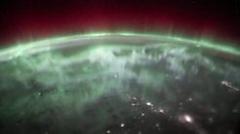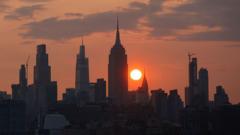In a breathtaking display of nature’s artistry, astronauts aboard the International Space Station (ISS) recently shared astonishing views of the aurora borealis, or Northern Lights, illuminating the skies above Canada. The footage, captured in January 2025, features a mesmerizing blend of greens and reds swirling against the backdrop of the Earth, visible even from the vast heights of space.
Traditionally, the Northern Lights are best viewed from the ground, particularly in high-latitude regions close to the Arctic Circle. However, from the vantage point of the ISS, this phenomenon can be perceived in an entirely new light. The visuals not only show the aurora borealis in full glory, but they also reveal city lights twinkling below, offering perspective on the human footprint amid the natural spectacle.
The aurora borealis occurs when charged particles from the Sun, known as solar wind, collide with Earth’s magnetic field, producing the colorful displays that captivate onlookers both on the ground and from above. The ISS orbits approximately 259 miles (417 km) above Earth, capturing the transient beauty of this celestial show as it passes into the dawn.
As technology continues to enhance our understanding and appreciation of such sights, the footage serves as a reminder of the connection between our planet and the cosmic interactions that shape our environment. Enthusiasts and scientists alike are drawn to the mysteries of the aurora borealis, a natural wonder that invites further exploration and understanding.
Traditionally, the Northern Lights are best viewed from the ground, particularly in high-latitude regions close to the Arctic Circle. However, from the vantage point of the ISS, this phenomenon can be perceived in an entirely new light. The visuals not only show the aurora borealis in full glory, but they also reveal city lights twinkling below, offering perspective on the human footprint amid the natural spectacle.
The aurora borealis occurs when charged particles from the Sun, known as solar wind, collide with Earth’s magnetic field, producing the colorful displays that captivate onlookers both on the ground and from above. The ISS orbits approximately 259 miles (417 km) above Earth, capturing the transient beauty of this celestial show as it passes into the dawn.
As technology continues to enhance our understanding and appreciation of such sights, the footage serves as a reminder of the connection between our planet and the cosmic interactions that shape our environment. Enthusiasts and scientists alike are drawn to the mysteries of the aurora borealis, a natural wonder that invites further exploration and understanding.



















